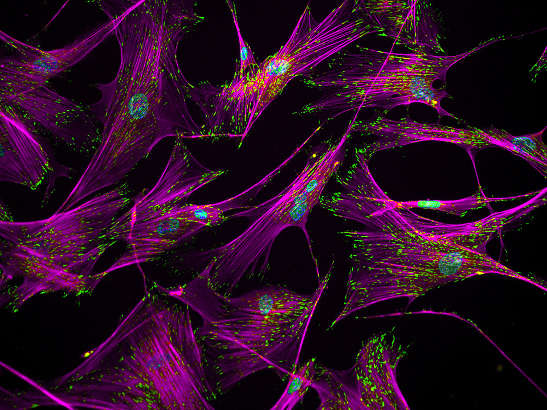SCIENTISTS have discovered how cells that usually help repair wounds can switch from friend to foe – and instead escalate tumour growth and cancer spread according to research published today in Cell Reports.
Cells in the body are surrounded by a network called the matrix that gives tissues structure. During wound healing in healthy tissue, cells called fibroblasts repair damaged parts of this network. But when fibroblasts surround cancer tissue they change the matrix to encourage cancer cells to spread.
Cancer Research UK-funded teams at the Francis Crick Institute and The Institute of Cancer Research, London, discovered that cancer cells can trick fibroblasts into turning on a protein called Cdc42EP3. Too much of this protein makes fibroblasts stronger and better at moving the matrix - allowing them to reshape the area around the tumour. This enables more blood vessels to feed the tumour - helping it to grow and spread.
Study leader Dr Erik Sahai, senior group leader at the Francis Crick Institute, said: “This exciting research reveals another way in which cancer can hijack the body’s wound healing process to help a tumour grow and spread. This work will help us to find ways to stop cancer cells tricking fibroblasts into inadvertently nurturing them, in the same way as a wound that the body must repair.”
Study lead author Dr Fernando Calvo, Team Leader in the Tumour Microenvironment at The Institute of Cancer Research, London, said: “Cancer cells don’t succeed in building a tumour alone – they recruit other cell types to manipulate the environment around them and to evade the body’s natural defences. This study shows how cancer cells make henchmen out of fibroblast cells – corrupting them so that they reorder the protein matrix around a tumour, and make the fibroblasts active supporters of their cause.”
Nell Barrie, Cancer Research UK’s senior science information manager, said: “One of the biggest challenges in successfully treating cancer is preventing it from spreading around the body, and controlling cancer that has already spread. This research is a crucial step in our understanding of how cells surrounding the tumour can help cancer grow and spread – and provides new avenues of research to stop the disease in its tracks.”
Sahai et al. Cdc42EP3/BORG2 and septin network enables mechano-transduction and the emergence of cancer-associated fibroblasts (2015) Cell Reports
